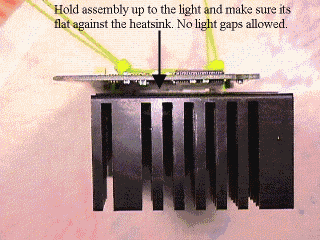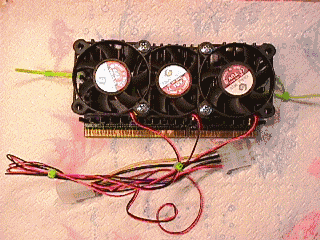
 |

The last step is to re-install the CPU fan that was removed from the heat sink. The Global Win came with one fan and since I had several more of these fans, I decided to add one more to each side of the heat sink. This involved adding four extra-length self tapping screws, and wiring all the fans together. Since I don't like to use electrical tape, I used heat shrink tubing and a soldering iron for the wiring.

The final step now is to install the CPU
cartridge into the motherboard. Remember to loop the outside cable ties
over the P2 rails, then pull them snug. You will find that it does not
need to be that tight. Don't forget to connect the four prong power connector,
or your fans will not engage.
Conclusion: Now sit back and enjoy your modification.
I did not perform any temperature measurements, but after about 10 minutes
running, I carefully placed my finger on the Tag RAM chip, and it was only
warm to the touch. My earlier temperature measurements where taken by measuring
the thermal transfer plate; therefore, I did not want to compare apples
to oranges. With this in mind, the thermal plate temperatures BEFORE the
modification ran in the range of 110 to 120°F. What a big improvement
to the Klamath CPU! And as an added bonus, the L2 cache chips are now open
to ambient case conditions, so they will run cooler too.